An Analysis of Principal Methods for Company Account Evaluation
VerifiedAdded on 2022/03/29
|25
|4694
|27
Report
AI Summary
This report comprehensively examines the principal methods for analyzing company accounts, including horizontal, vertical, ratio, and DuPont analysis. It provides a detailed overview of each method, explaining their application and significance in evaluating a company's financial performance. The report also delves into the limitations of each method, such as the failure of horizontal analysis to account for policy changes and the limited scope of vertical analysis. Furthermore, it explores contemporary methods to overcome these shortcomings, including Economic Value Added (EVA), the Capital Asset Pricing Model (CAPM), and the Efficient Market Hypothesis (EMH). The report uses examples from Booker Plc and Tate & Lyle to illustrate the application of these methods and concludes with a discussion on how these methods can be used to improve financial analysis. This report is a valuable resource for understanding financial statement analysis and its practical applications.

“Principal Methods of analysing company Accounts”
Words: 3000
Words: 3000
Paraphrase This Document
Need a fresh take? Get an instant paraphrase of this document with our AI Paraphraser
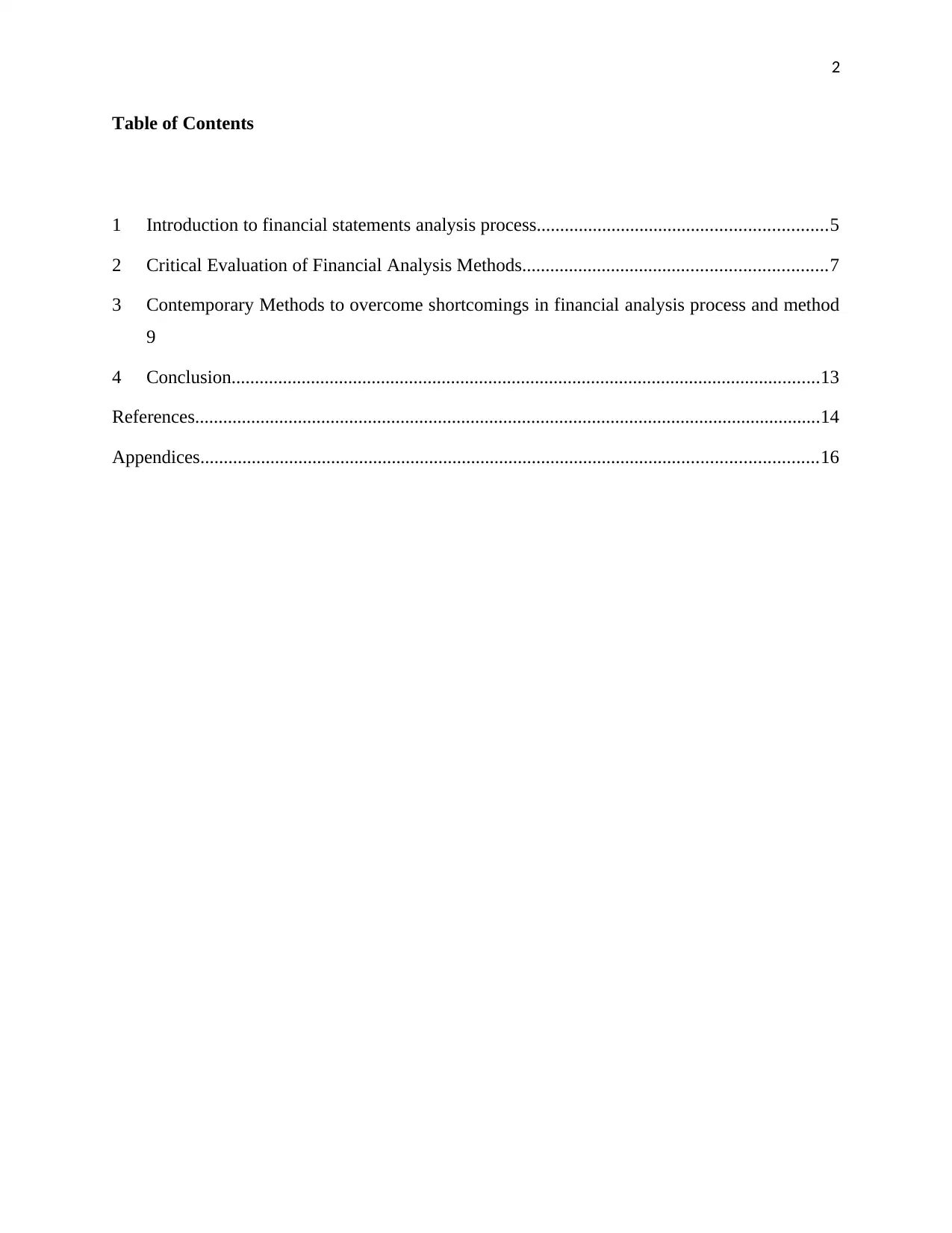
2
Table of Contents
1 Introduction to financial statements analysis process..............................................................5
2 Critical Evaluation of Financial Analysis Methods.................................................................7
3 Contemporary Methods to overcome shortcomings in financial analysis process and method
9
4 Conclusion..............................................................................................................................13
References......................................................................................................................................14
Appendices....................................................................................................................................16
Table of Contents
1 Introduction to financial statements analysis process..............................................................5
2 Critical Evaluation of Financial Analysis Methods.................................................................7
3 Contemporary Methods to overcome shortcomings in financial analysis process and method
9
4 Conclusion..............................................................................................................................13
References......................................................................................................................................14
Appendices....................................................................................................................................16
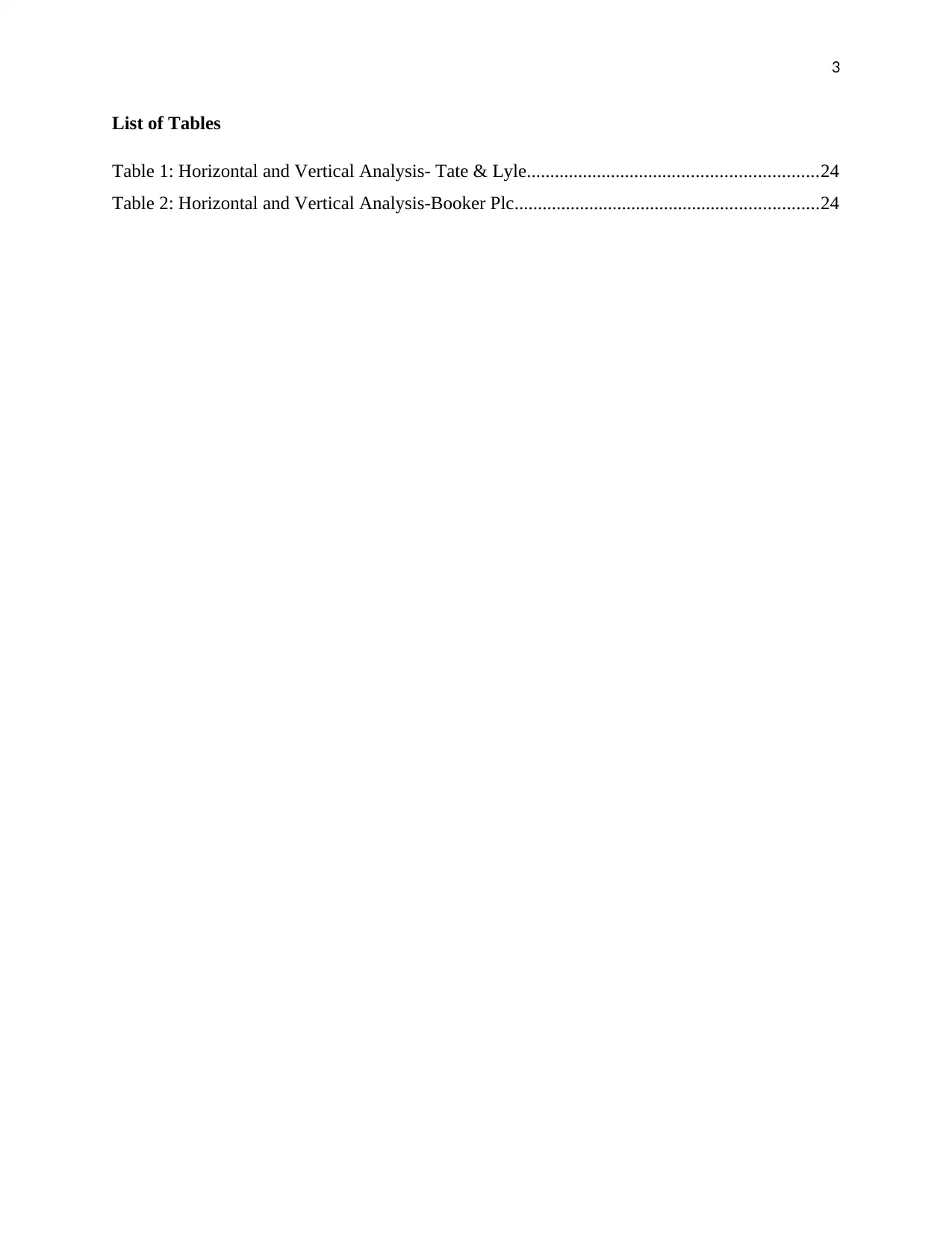
3
List of Tables
Table 1: Horizontal and Vertical Analysis- Tate & Lyle..............................................................24
Table 2: Horizontal and Vertical Analysis-Booker Plc.................................................................24
List of Tables
Table 1: Horizontal and Vertical Analysis- Tate & Lyle..............................................................24
Table 2: Horizontal and Vertical Analysis-Booker Plc.................................................................24
⊘ This is a preview!⊘
Do you want full access?
Subscribe today to unlock all pages.

Trusted by 1+ million students worldwide
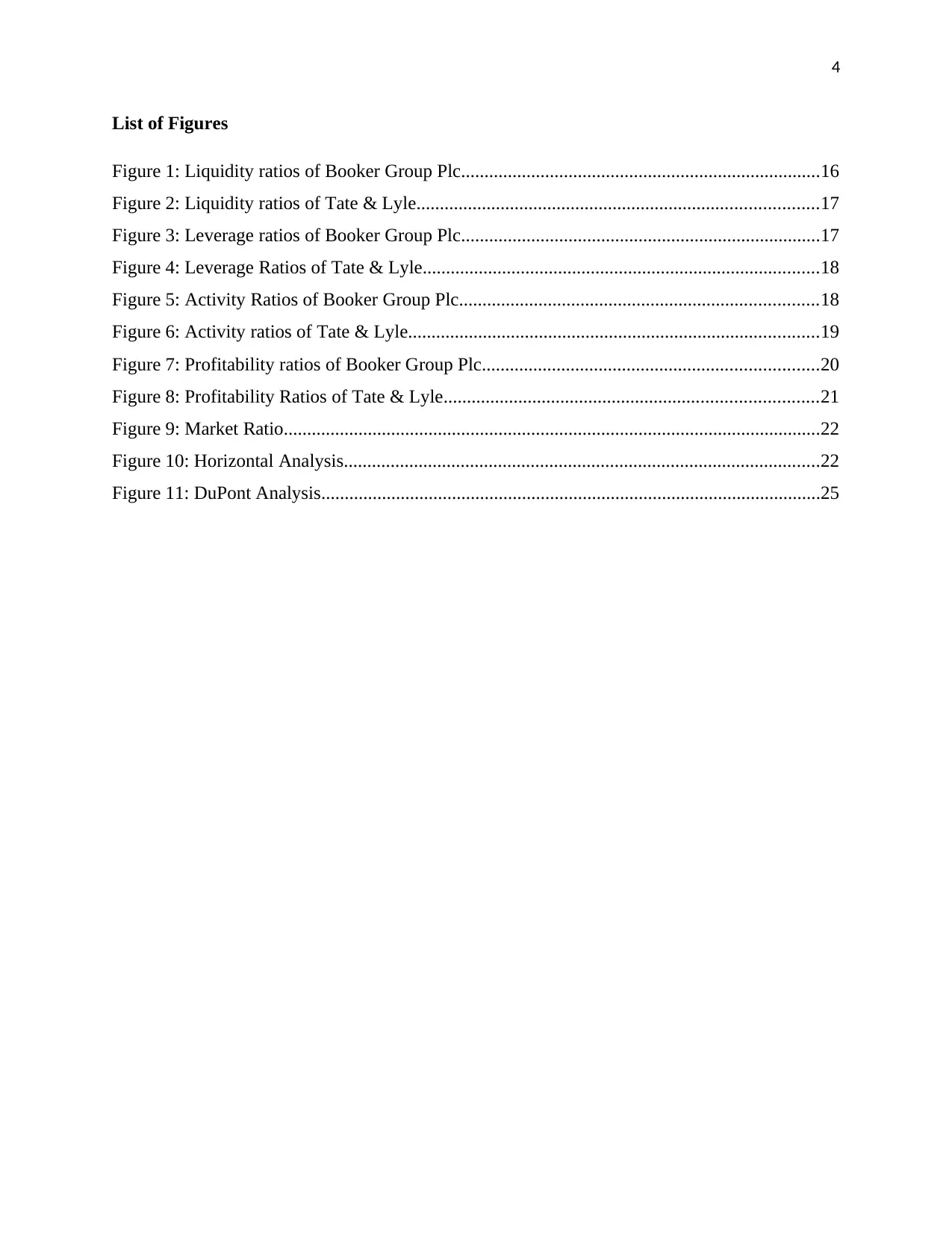
4
List of Figures
Figure 1: Liquidity ratios of Booker Group Plc.............................................................................16
Figure 2: Liquidity ratios of Tate & Lyle......................................................................................17
Figure 3: Leverage ratios of Booker Group Plc.............................................................................17
Figure 4: Leverage Ratios of Tate & Lyle.....................................................................................18
Figure 5: Activity Ratios of Booker Group Plc.............................................................................18
Figure 6: Activity ratios of Tate & Lyle........................................................................................19
Figure 7: Profitability ratios of Booker Group Plc........................................................................20
Figure 8: Profitability Ratios of Tate & Lyle................................................................................21
Figure 9: Market Ratio...................................................................................................................22
Figure 10: Horizontal Analysis......................................................................................................22
Figure 11: DuPont Analysis...........................................................................................................25
List of Figures
Figure 1: Liquidity ratios of Booker Group Plc.............................................................................16
Figure 2: Liquidity ratios of Tate & Lyle......................................................................................17
Figure 3: Leverage ratios of Booker Group Plc.............................................................................17
Figure 4: Leverage Ratios of Tate & Lyle.....................................................................................18
Figure 5: Activity Ratios of Booker Group Plc.............................................................................18
Figure 6: Activity ratios of Tate & Lyle........................................................................................19
Figure 7: Profitability ratios of Booker Group Plc........................................................................20
Figure 8: Profitability Ratios of Tate & Lyle................................................................................21
Figure 9: Market Ratio...................................................................................................................22
Figure 10: Horizontal Analysis......................................................................................................22
Figure 11: DuPont Analysis...........................................................................................................25
Paraphrase This Document
Need a fresh take? Get an instant paraphrase of this document with our AI Paraphraser
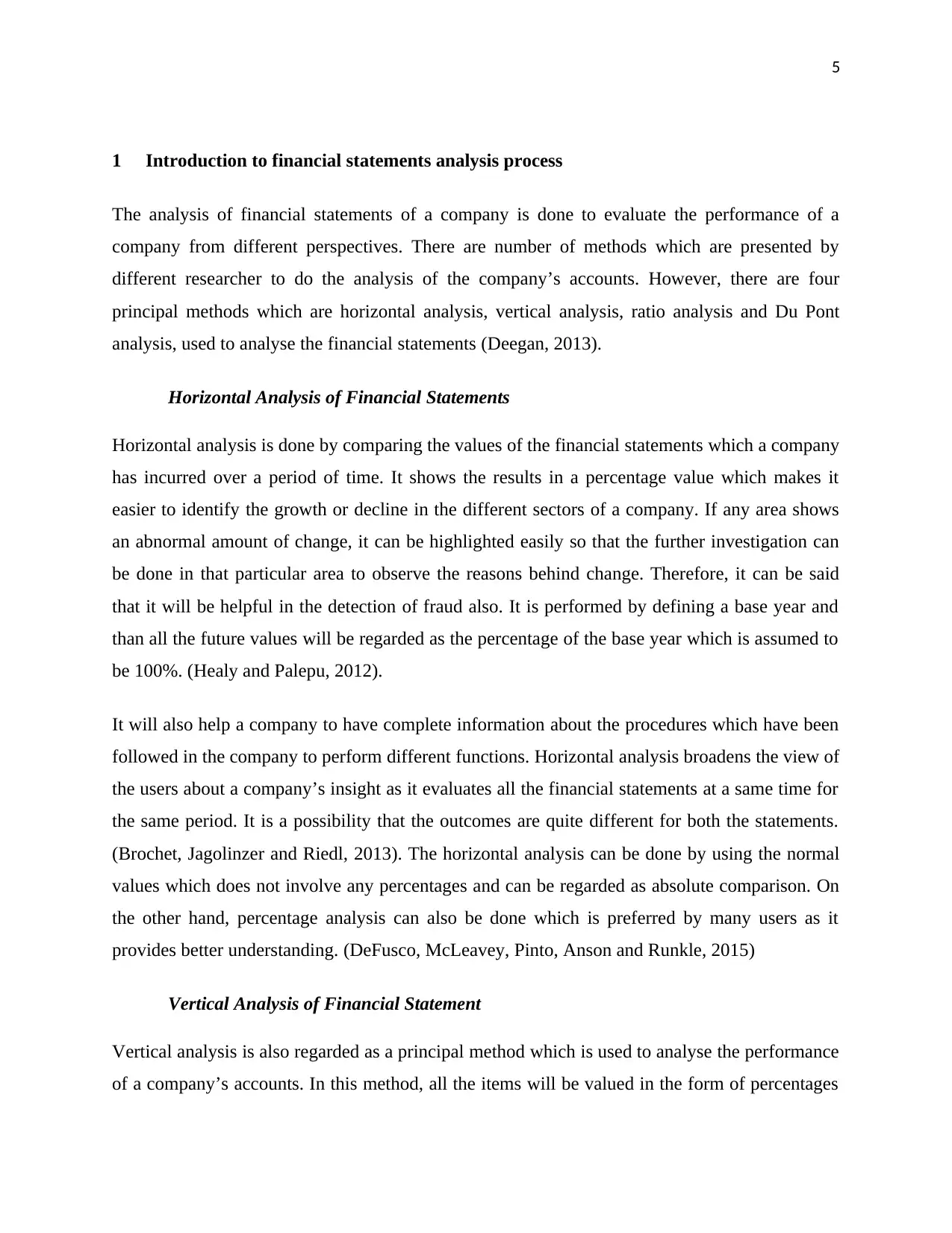
5
1 Introduction to financial statements analysis process
The analysis of financial statements of a company is done to evaluate the performance of a
company from different perspectives. There are number of methods which are presented by
different researcher to do the analysis of the company’s accounts. However, there are four
principal methods which are horizontal analysis, vertical analysis, ratio analysis and Du Pont
analysis, used to analyse the financial statements (Deegan, 2013).
Horizontal Analysis of Financial Statements
Horizontal analysis is done by comparing the values of the financial statements which a company
has incurred over a period of time. It shows the results in a percentage value which makes it
easier to identify the growth or decline in the different sectors of a company. If any area shows
an abnormal amount of change, it can be highlighted easily so that the further investigation can
be done in that particular area to observe the reasons behind change. Therefore, it can be said
that it will be helpful in the detection of fraud also. It is performed by defining a base year and
than all the future values will be regarded as the percentage of the base year which is assumed to
be 100%. (Healy and Palepu, 2012).
It will also help a company to have complete information about the procedures which have been
followed in the company to perform different functions. Horizontal analysis broadens the view of
the users about a company’s insight as it evaluates all the financial statements at a same time for
the same period. It is a possibility that the outcomes are quite different for both the statements.
(Brochet, Jagolinzer and Riedl, 2013). The horizontal analysis can be done by using the normal
values which does not involve any percentages and can be regarded as absolute comparison. On
the other hand, percentage analysis can also be done which is preferred by many users as it
provides better understanding. (DeFusco, McLeavey, Pinto, Anson and Runkle, 2015)
Vertical Analysis of Financial Statement
Vertical analysis is also regarded as a principal method which is used to analyse the performance
of a company’s accounts. In this method, all the items will be valued in the form of percentages
1 Introduction to financial statements analysis process
The analysis of financial statements of a company is done to evaluate the performance of a
company from different perspectives. There are number of methods which are presented by
different researcher to do the analysis of the company’s accounts. However, there are four
principal methods which are horizontal analysis, vertical analysis, ratio analysis and Du Pont
analysis, used to analyse the financial statements (Deegan, 2013).
Horizontal Analysis of Financial Statements
Horizontal analysis is done by comparing the values of the financial statements which a company
has incurred over a period of time. It shows the results in a percentage value which makes it
easier to identify the growth or decline in the different sectors of a company. If any area shows
an abnormal amount of change, it can be highlighted easily so that the further investigation can
be done in that particular area to observe the reasons behind change. Therefore, it can be said
that it will be helpful in the detection of fraud also. It is performed by defining a base year and
than all the future values will be regarded as the percentage of the base year which is assumed to
be 100%. (Healy and Palepu, 2012).
It will also help a company to have complete information about the procedures which have been
followed in the company to perform different functions. Horizontal analysis broadens the view of
the users about a company’s insight as it evaluates all the financial statements at a same time for
the same period. It is a possibility that the outcomes are quite different for both the statements.
(Brochet, Jagolinzer and Riedl, 2013). The horizontal analysis can be done by using the normal
values which does not involve any percentages and can be regarded as absolute comparison. On
the other hand, percentage analysis can also be done which is preferred by many users as it
provides better understanding. (DeFusco, McLeavey, Pinto, Anson and Runkle, 2015)
Vertical Analysis of Financial Statement
Vertical analysis is also regarded as a principal method which is used to analyse the performance
of a company’s accounts. In this method, all the items will be valued in the form of percentages
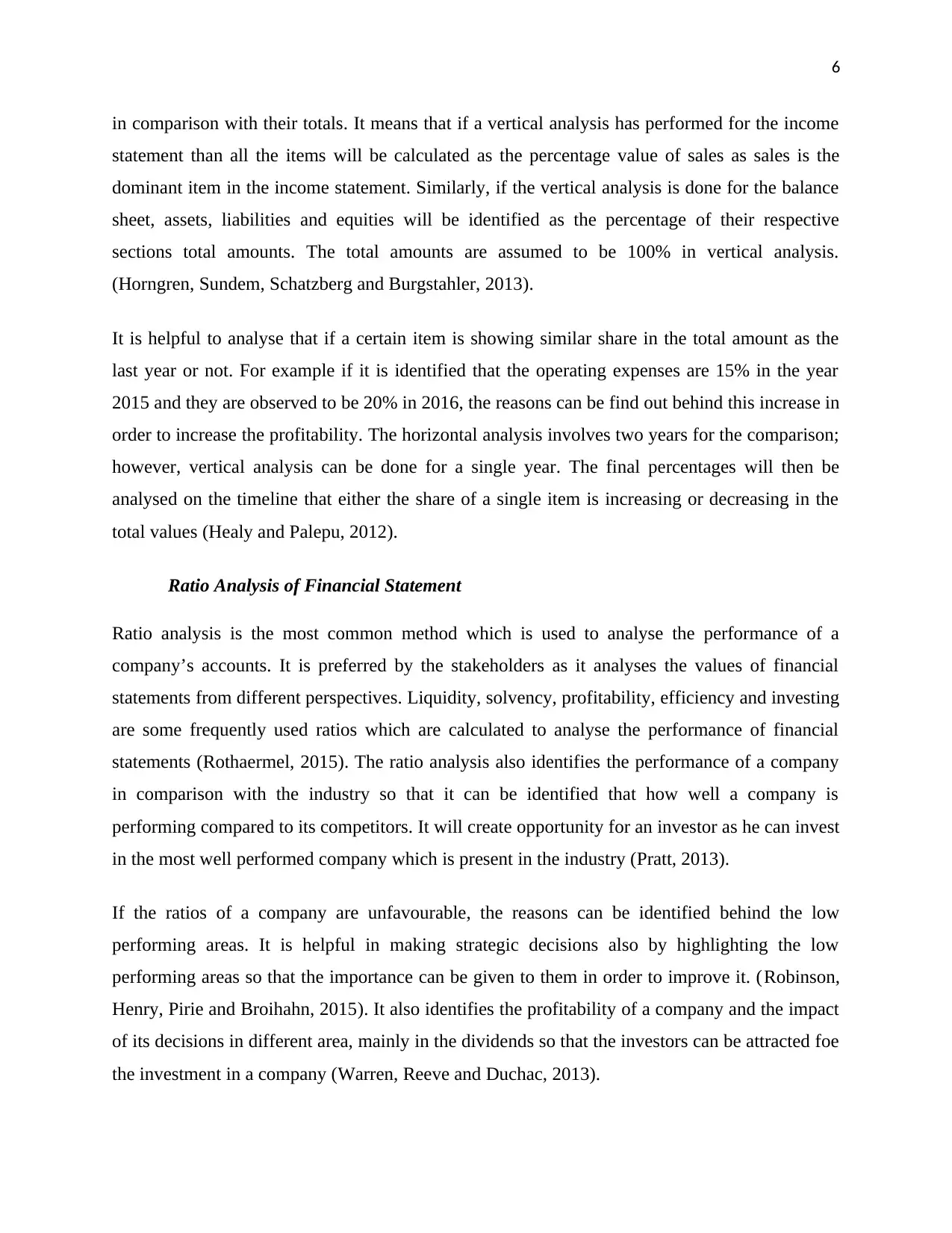
6
in comparison with their totals. It means that if a vertical analysis has performed for the income
statement than all the items will be calculated as the percentage value of sales as sales is the
dominant item in the income statement. Similarly, if the vertical analysis is done for the balance
sheet, assets, liabilities and equities will be identified as the percentage of their respective
sections total amounts. The total amounts are assumed to be 100% in vertical analysis.
(Horngren, Sundem, Schatzberg and Burgstahler, 2013).
It is helpful to analyse that if a certain item is showing similar share in the total amount as the
last year or not. For example if it is identified that the operating expenses are 15% in the year
2015 and they are observed to be 20% in 2016, the reasons can be find out behind this increase in
order to increase the profitability. The horizontal analysis involves two years for the comparison;
however, vertical analysis can be done for a single year. The final percentages will then be
analysed on the timeline that either the share of a single item is increasing or decreasing in the
total values (Healy and Palepu, 2012).
Ratio Analysis of Financial Statement
Ratio analysis is the most common method which is used to analyse the performance of a
company’s accounts. It is preferred by the stakeholders as it analyses the values of financial
statements from different perspectives. Liquidity, solvency, profitability, efficiency and investing
are some frequently used ratios which are calculated to analyse the performance of financial
statements (Rothaermel, 2015). The ratio analysis also identifies the performance of a company
in comparison with the industry so that it can be identified that how well a company is
performing compared to its competitors. It will create opportunity for an investor as he can invest
in the most well performed company which is present in the industry (Pratt, 2013).
If the ratios of a company are unfavourable, the reasons can be identified behind the low
performing areas. It is helpful in making strategic decisions also by highlighting the low
performing areas so that the importance can be given to them in order to improve it. (Robinson,
Henry, Pirie and Broihahn, 2015). It also identifies the profitability of a company and the impact
of its decisions in different area, mainly in the dividends so that the investors can be attracted foe
the investment in a company (Warren, Reeve and Duchac, 2013).
in comparison with their totals. It means that if a vertical analysis has performed for the income
statement than all the items will be calculated as the percentage value of sales as sales is the
dominant item in the income statement. Similarly, if the vertical analysis is done for the balance
sheet, assets, liabilities and equities will be identified as the percentage of their respective
sections total amounts. The total amounts are assumed to be 100% in vertical analysis.
(Horngren, Sundem, Schatzberg and Burgstahler, 2013).
It is helpful to analyse that if a certain item is showing similar share in the total amount as the
last year or not. For example if it is identified that the operating expenses are 15% in the year
2015 and they are observed to be 20% in 2016, the reasons can be find out behind this increase in
order to increase the profitability. The horizontal analysis involves two years for the comparison;
however, vertical analysis can be done for a single year. The final percentages will then be
analysed on the timeline that either the share of a single item is increasing or decreasing in the
total values (Healy and Palepu, 2012).
Ratio Analysis of Financial Statement
Ratio analysis is the most common method which is used to analyse the performance of a
company’s accounts. It is preferred by the stakeholders as it analyses the values of financial
statements from different perspectives. Liquidity, solvency, profitability, efficiency and investing
are some frequently used ratios which are calculated to analyse the performance of financial
statements (Rothaermel, 2015). The ratio analysis also identifies the performance of a company
in comparison with the industry so that it can be identified that how well a company is
performing compared to its competitors. It will create opportunity for an investor as he can invest
in the most well performed company which is present in the industry (Pratt, 2013).
If the ratios of a company are unfavourable, the reasons can be identified behind the low
performing areas. It is helpful in making strategic decisions also by highlighting the low
performing areas so that the importance can be given to them in order to improve it. (Robinson,
Henry, Pirie and Broihahn, 2015). It also identifies the profitability of a company and the impact
of its decisions in different area, mainly in the dividends so that the investors can be attracted foe
the investment in a company (Warren, Reeve and Duchac, 2013).
⊘ This is a preview!⊘
Do you want full access?
Subscribe today to unlock all pages.

Trusted by 1+ million students worldwide
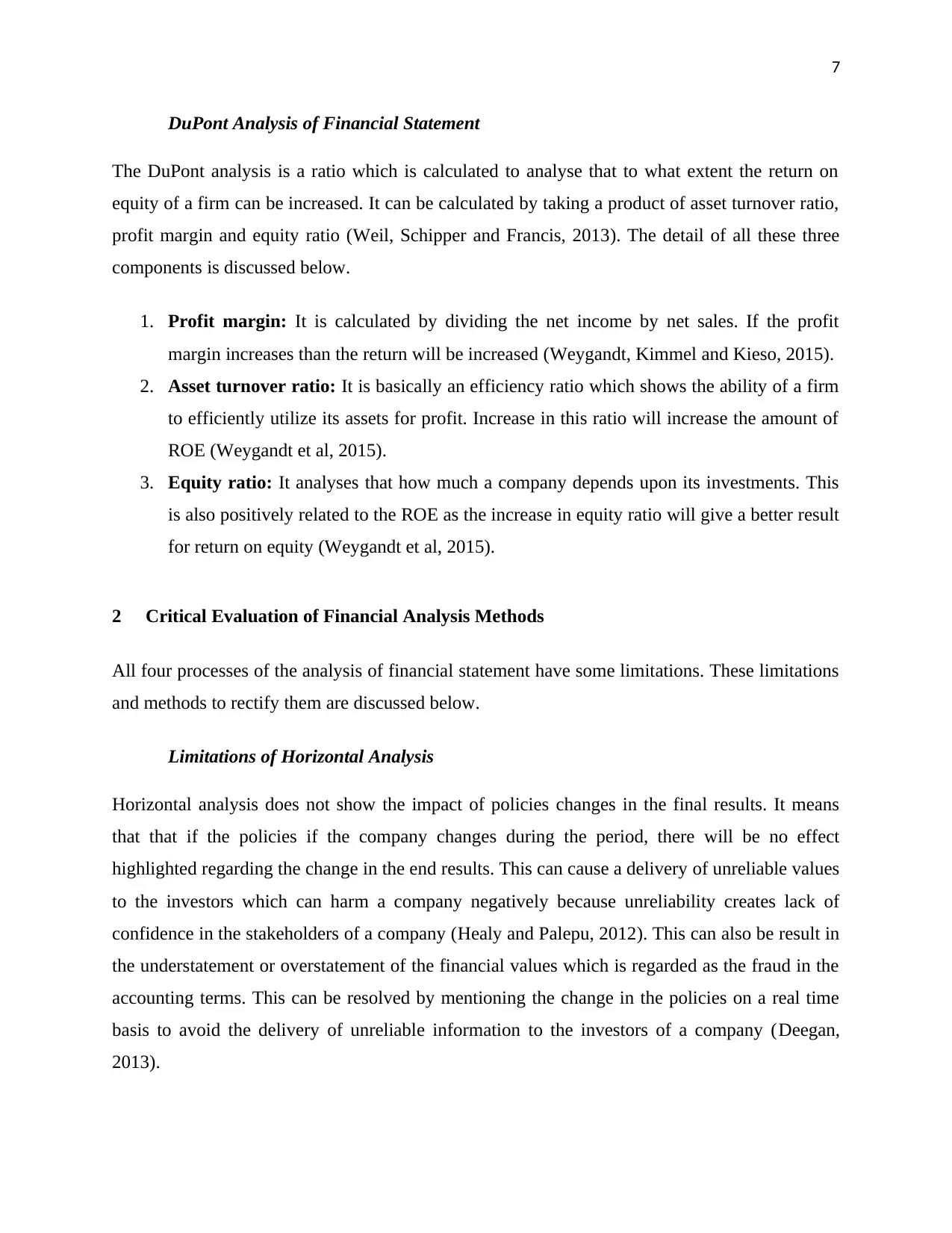
7
DuPont Analysis of Financial Statement
The DuPont analysis is a ratio which is calculated to analyse that to what extent the return on
equity of a firm can be increased. It can be calculated by taking a product of asset turnover ratio,
profit margin and equity ratio (Weil, Schipper and Francis, 2013). The detail of all these three
components is discussed below.
1. Profit margin: It is calculated by dividing the net income by net sales. If the profit
margin increases than the return will be increased (Weygandt, Kimmel and Kieso, 2015).
2. Asset turnover ratio: It is basically an efficiency ratio which shows the ability of a firm
to efficiently utilize its assets for profit. Increase in this ratio will increase the amount of
ROE (Weygandt et al, 2015).
3. Equity ratio: It analyses that how much a company depends upon its investments. This
is also positively related to the ROE as the increase in equity ratio will give a better result
for return on equity (Weygandt et al, 2015).
2 Critical Evaluation of Financial Analysis Methods
All four processes of the analysis of financial statement have some limitations. These limitations
and methods to rectify them are discussed below.
Limitations of Horizontal Analysis
Horizontal analysis does not show the impact of policies changes in the final results. It means
that that if the policies if the company changes during the period, there will be no effect
highlighted regarding the change in the end results. This can cause a delivery of unreliable values
to the investors which can harm a company negatively because unreliability creates lack of
confidence in the stakeholders of a company (Healy and Palepu, 2012). This can also be result in
the understatement or overstatement of the financial values which is regarded as the fraud in the
accounting terms. This can be resolved by mentioning the change in the policies on a real time
basis to avoid the delivery of unreliable information to the investors of a company (Deegan,
2013).
DuPont Analysis of Financial Statement
The DuPont analysis is a ratio which is calculated to analyse that to what extent the return on
equity of a firm can be increased. It can be calculated by taking a product of asset turnover ratio,
profit margin and equity ratio (Weil, Schipper and Francis, 2013). The detail of all these three
components is discussed below.
1. Profit margin: It is calculated by dividing the net income by net sales. If the profit
margin increases than the return will be increased (Weygandt, Kimmel and Kieso, 2015).
2. Asset turnover ratio: It is basically an efficiency ratio which shows the ability of a firm
to efficiently utilize its assets for profit. Increase in this ratio will increase the amount of
ROE (Weygandt et al, 2015).
3. Equity ratio: It analyses that how much a company depends upon its investments. This
is also positively related to the ROE as the increase in equity ratio will give a better result
for return on equity (Weygandt et al, 2015).
2 Critical Evaluation of Financial Analysis Methods
All four processes of the analysis of financial statement have some limitations. These limitations
and methods to rectify them are discussed below.
Limitations of Horizontal Analysis
Horizontal analysis does not show the impact of policies changes in the final results. It means
that that if the policies if the company changes during the period, there will be no effect
highlighted regarding the change in the end results. This can cause a delivery of unreliable values
to the investors which can harm a company negatively because unreliability creates lack of
confidence in the stakeholders of a company (Healy and Palepu, 2012). This can also be result in
the understatement or overstatement of the financial values which is regarded as the fraud in the
accounting terms. This can be resolved by mentioning the change in the policies on a real time
basis to avoid the delivery of unreliable information to the investors of a company (Deegan,
2013).
Paraphrase This Document
Need a fresh take? Get an instant paraphrase of this document with our AI Paraphraser

8
Limitations of Vertical Analysis
The limitation of vertical analysis is that it compares the data of one year only which results in
the limited information to the investors. The limited information will not be helpful for the
decision making purpose and if the decision is taken on the basis of this than the shareholders of
the company are likely to face loss in the future (Warren et al, 2013). It is necessary for a
company to provide all the material information to the investors so that they have a clear
understanding of the financial position of a company. Vertical analysis is more helpful for the
management of a company as it helps to take strategic decisions but it is not much helpful for the
investors (Rothaermel, 2015). This limitation can be rectified by presenting the information of
multiple years and then compare all the values over the period of time to show the trend of a
company in recent years.
Limitations of Ratio analysis
Ratio analysis is considered as the most effective method for the analysis of financial statement
as it tells s about the performance of a company in various areas. The business activities and the
operations which are carried by the business can be evaluated on a wider perspective by the use
of ratio analysis (Robinson et al, 2015). However, with all its positive points, it has also a
drawback that it ignores the effect of horizontal and vertical analysis of a company’s financial
statements. The ratio analysis identifies the percentages of different operational activities and it
is highly anticipated by the investors while decision making process but the absence of both the
analysis is its limitation (DeFusco et al, 2015). This can be solved by the addition of both the
analysis that first the ratios should be calculated and then the analysis will be done over the
period of time.
Limitations of DuPont Analysis
The technique evaluates the performance of the firm while analyzing the generated return from
employed equity capital. On the other hand the DuPont analysis also involves several limitations.
The major limitation is that it does not consider a cost of capital; moreover, the analysis of the
sub three categories is irrelevant to conclude the financial performance of the firm. The DuPont
analysis evaluates financial performance by assessing accounting information that can be
Limitations of Vertical Analysis
The limitation of vertical analysis is that it compares the data of one year only which results in
the limited information to the investors. The limited information will not be helpful for the
decision making purpose and if the decision is taken on the basis of this than the shareholders of
the company are likely to face loss in the future (Warren et al, 2013). It is necessary for a
company to provide all the material information to the investors so that they have a clear
understanding of the financial position of a company. Vertical analysis is more helpful for the
management of a company as it helps to take strategic decisions but it is not much helpful for the
investors (Rothaermel, 2015). This limitation can be rectified by presenting the information of
multiple years and then compare all the values over the period of time to show the trend of a
company in recent years.
Limitations of Ratio analysis
Ratio analysis is considered as the most effective method for the analysis of financial statement
as it tells s about the performance of a company in various areas. The business activities and the
operations which are carried by the business can be evaluated on a wider perspective by the use
of ratio analysis (Robinson et al, 2015). However, with all its positive points, it has also a
drawback that it ignores the effect of horizontal and vertical analysis of a company’s financial
statements. The ratio analysis identifies the percentages of different operational activities and it
is highly anticipated by the investors while decision making process but the absence of both the
analysis is its limitation (DeFusco et al, 2015). This can be solved by the addition of both the
analysis that first the ratios should be calculated and then the analysis will be done over the
period of time.
Limitations of DuPont Analysis
The technique evaluates the performance of the firm while analyzing the generated return from
employed equity capital. On the other hand the DuPont analysis also involves several limitations.
The major limitation is that it does not consider a cost of capital; moreover, the analysis of the
sub three categories is irrelevant to conclude the financial performance of the firm. The DuPont
analysis evaluates financial performance by assessing accounting information that can be

9
modified as per the situation. Thus, the financial performance of the firm cannot measured
effectively (Rakicevic, Milosevic, Petrovic and Radojevic, 2016)
3 Contemporary Methods to overcome shortcomings in financial analysis process and
method
Economic Value Added
For the evaluation the performance of the business, economic value added method can be used. It
is used when the cost of the capital of a firm is lower than the profit that is computed after tax.
This is termed as effective model being used by the companies (Koopman, Wang and Wei,
2014). Economic Value Added is the estimation of the economic profits or determines the value
that has been created by the firm from the employed capital in business operations (Patel, 2015).
It also measures business performance by analyzing the difference between the profits and
opportunity cost of business capital. It analyzes business performance by analyzing the economic
profits and its comparison with the cost of capital acquired by the firm (Chetty, Friedman and
Rockoff, 2016).
CAPM model
The CAPM model is considered as the capital asset pricing model and evaluates business cost
while analyzing the cost incurred for financing business. The model compares the cost raised
from equity capital as compared to debt capital about the risk involved in the project (Dempsey,
2013). To compare the generated sales by both firms, it has been analysed that the sales of
Booker Plc are increasing; however, the stable sales position has been analysed in the case of
T&L Plc in the upcoming periods. The projected beta for the Booker Plc is 0.63 according to
Booker Plc (2016), and it is 0.31 for Tate & Lyle as analyze from the peer analysis of the
financial information (Tate & Lyle, 2016).
Efficient Market Hypothesis
The Efficient Market Hypothesis has been considered as an investment approach that declares
that it is not possible for the stock to beat the market concerning the market efficiency and
information revealing in the capital market. The concept declares the price of the stock always
modified as per the situation. Thus, the financial performance of the firm cannot measured
effectively (Rakicevic, Milosevic, Petrovic and Radojevic, 2016)
3 Contemporary Methods to overcome shortcomings in financial analysis process and
method
Economic Value Added
For the evaluation the performance of the business, economic value added method can be used. It
is used when the cost of the capital of a firm is lower than the profit that is computed after tax.
This is termed as effective model being used by the companies (Koopman, Wang and Wei,
2014). Economic Value Added is the estimation of the economic profits or determines the value
that has been created by the firm from the employed capital in business operations (Patel, 2015).
It also measures business performance by analyzing the difference between the profits and
opportunity cost of business capital. It analyzes business performance by analyzing the economic
profits and its comparison with the cost of capital acquired by the firm (Chetty, Friedman and
Rockoff, 2016).
CAPM model
The CAPM model is considered as the capital asset pricing model and evaluates business cost
while analyzing the cost incurred for financing business. The model compares the cost raised
from equity capital as compared to debt capital about the risk involved in the project (Dempsey,
2013). To compare the generated sales by both firms, it has been analysed that the sales of
Booker Plc are increasing; however, the stable sales position has been analysed in the case of
T&L Plc in the upcoming periods. The projected beta for the Booker Plc is 0.63 according to
Booker Plc (2016), and it is 0.31 for Tate & Lyle as analyze from the peer analysis of the
financial information (Tate & Lyle, 2016).
Efficient Market Hypothesis
The Efficient Market Hypothesis has been considered as an investment approach that declares
that it is not possible for the stock to beat the market concerning the market efficiency and
information revealing in the capital market. The concept declares the price of the stock always
⊘ This is a preview!⊘
Do you want full access?
Subscribe today to unlock all pages.

Trusted by 1+ million students worldwide
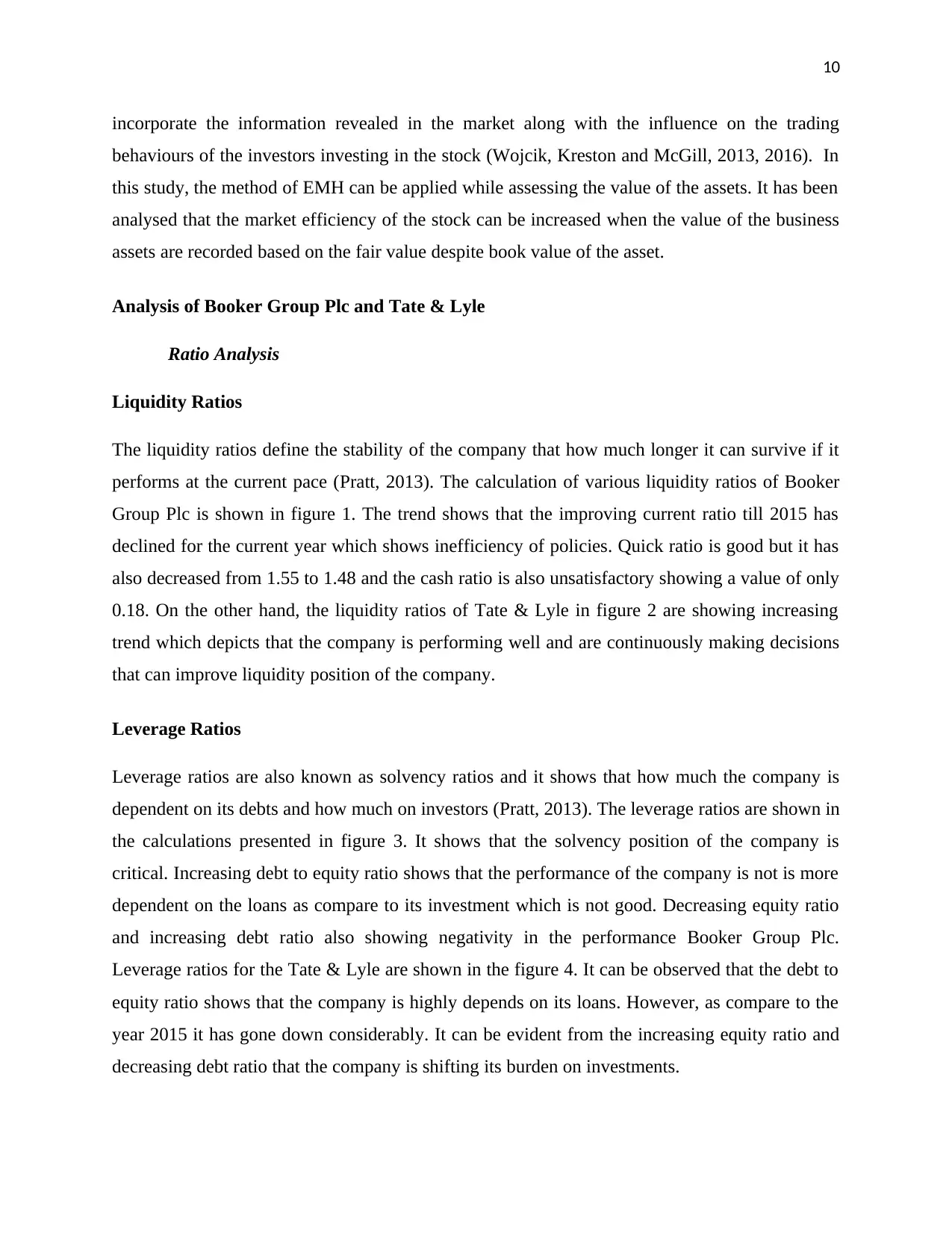
10
incorporate the information revealed in the market along with the influence on the trading
behaviours of the investors investing in the stock (Wojcik, Kreston and McGill, 2013, 2016). In
this study, the method of EMH can be applied while assessing the value of the assets. It has been
analysed that the market efficiency of the stock can be increased when the value of the business
assets are recorded based on the fair value despite book value of the asset.
Analysis of Booker Group Plc and Tate & Lyle
Ratio Analysis
Liquidity Ratios
The liquidity ratios define the stability of the company that how much longer it can survive if it
performs at the current pace (Pratt, 2013). The calculation of various liquidity ratios of Booker
Group Plc is shown in figure 1. The trend shows that the improving current ratio till 2015 has
declined for the current year which shows inefficiency of policies. Quick ratio is good but it has
also decreased from 1.55 to 1.48 and the cash ratio is also unsatisfactory showing a value of only
0.18. On the other hand, the liquidity ratios of Tate & Lyle in figure 2 are showing increasing
trend which depicts that the company is performing well and are continuously making decisions
that can improve liquidity position of the company.
Leverage Ratios
Leverage ratios are also known as solvency ratios and it shows that how much the company is
dependent on its debts and how much on investors (Pratt, 2013). The leverage ratios are shown in
the calculations presented in figure 3. It shows that the solvency position of the company is
critical. Increasing debt to equity ratio shows that the performance of the company is not is more
dependent on the loans as compare to its investment which is not good. Decreasing equity ratio
and increasing debt ratio also showing negativity in the performance Booker Group Plc.
Leverage ratios for the Tate & Lyle are shown in the figure 4. It can be observed that the debt to
equity ratio shows that the company is highly depends on its loans. However, as compare to the
year 2015 it has gone down considerably. It can be evident from the increasing equity ratio and
decreasing debt ratio that the company is shifting its burden on investments.
incorporate the information revealed in the market along with the influence on the trading
behaviours of the investors investing in the stock (Wojcik, Kreston and McGill, 2013, 2016). In
this study, the method of EMH can be applied while assessing the value of the assets. It has been
analysed that the market efficiency of the stock can be increased when the value of the business
assets are recorded based on the fair value despite book value of the asset.
Analysis of Booker Group Plc and Tate & Lyle
Ratio Analysis
Liquidity Ratios
The liquidity ratios define the stability of the company that how much longer it can survive if it
performs at the current pace (Pratt, 2013). The calculation of various liquidity ratios of Booker
Group Plc is shown in figure 1. The trend shows that the improving current ratio till 2015 has
declined for the current year which shows inefficiency of policies. Quick ratio is good but it has
also decreased from 1.55 to 1.48 and the cash ratio is also unsatisfactory showing a value of only
0.18. On the other hand, the liquidity ratios of Tate & Lyle in figure 2 are showing increasing
trend which depicts that the company is performing well and are continuously making decisions
that can improve liquidity position of the company.
Leverage Ratios
Leverage ratios are also known as solvency ratios and it shows that how much the company is
dependent on its debts and how much on investors (Pratt, 2013). The leverage ratios are shown in
the calculations presented in figure 3. It shows that the solvency position of the company is
critical. Increasing debt to equity ratio shows that the performance of the company is not is more
dependent on the loans as compare to its investment which is not good. Decreasing equity ratio
and increasing debt ratio also showing negativity in the performance Booker Group Plc.
Leverage ratios for the Tate & Lyle are shown in the figure 4. It can be observed that the debt to
equity ratio shows that the company is highly depends on its loans. However, as compare to the
year 2015 it has gone down considerably. It can be evident from the increasing equity ratio and
decreasing debt ratio that the company is shifting its burden on investments.
Paraphrase This Document
Need a fresh take? Get an instant paraphrase of this document with our AI Paraphraser

11
Activity Ratios
Activity ratios show that how efficiently the company performs its day to day operations. These
ratios are also known as efficiency ratios (Weil et al, 2013). Figure 5 shows the activity ratios
calculation for the Booker Group Plc. The performance of the company is satisfactory regarding
the current year activity ratios as they are showing good values. However, it is observed that they
all have been decreased except day’s sales in inventory from the past year which shows a
decrease in efficiency. Figure 6 shows activity ratios of Tate & Lyle which indicate that the
efficiency of the company is decreasing as the ratios are falling in the values.
Profitability ratios
Profitability ratios are calculated to define the ability of the company to generate the profit.
Different ratios are calculated to define the profitability of the company (Weygandt et al, 2015).
The calculation of the profitability ratio of Booker Plc is shown in the figure 7. ROCE and ROE
are showing increased values which are good for the company while the remaining ratios are
constant which is not a positive factor because it is showing that the company has not made any
progress since past years. Profitability ratios for Tate & Lyle can be observed in the figure 8. It
can be observed from the calculations that the performance of the company is increasing
regarding the profitability as the ratios are showing increasing trends. However, the company has
to manage its operating expenses as the difference between gross profit margin and net profit
margin is quite high i.e. 33%.
Market ratio
The market ratio measures the performance of the firm illustrating the return earned by
shareholders from investing funds in the business. The earnings per share measures generated
income from the invested funds in the business (Prett, 2013). The comparison of both the
companies according to the market ratio is illustrated in the figure 9. The earnings per share of
T&L are 0.7 in 2015 and increased to 0.35 in 2016. However, the EPS of Booker Plc has
remained constant for both the years. The payout ratio of Tate & Lyle is also more favourable as
it is growing more rapidly as compare to the Booker Plc. The dividend yield measures business
Activity Ratios
Activity ratios show that how efficiently the company performs its day to day operations. These
ratios are also known as efficiency ratios (Weil et al, 2013). Figure 5 shows the activity ratios
calculation for the Booker Group Plc. The performance of the company is satisfactory regarding
the current year activity ratios as they are showing good values. However, it is observed that they
all have been decreased except day’s sales in inventory from the past year which shows a
decrease in efficiency. Figure 6 shows activity ratios of Tate & Lyle which indicate that the
efficiency of the company is decreasing as the ratios are falling in the values.
Profitability ratios
Profitability ratios are calculated to define the ability of the company to generate the profit.
Different ratios are calculated to define the profitability of the company (Weygandt et al, 2015).
The calculation of the profitability ratio of Booker Plc is shown in the figure 7. ROCE and ROE
are showing increased values which are good for the company while the remaining ratios are
constant which is not a positive factor because it is showing that the company has not made any
progress since past years. Profitability ratios for Tate & Lyle can be observed in the figure 8. It
can be observed from the calculations that the performance of the company is increasing
regarding the profitability as the ratios are showing increasing trends. However, the company has
to manage its operating expenses as the difference between gross profit margin and net profit
margin is quite high i.e. 33%.
Market ratio
The market ratio measures the performance of the firm illustrating the return earned by
shareholders from investing funds in the business. The earnings per share measures generated
income from the invested funds in the business (Prett, 2013). The comparison of both the
companies according to the market ratio is illustrated in the figure 9. The earnings per share of
T&L are 0.7 in 2015 and increased to 0.35 in 2016. However, the EPS of Booker Plc has
remained constant for both the years. The payout ratio of Tate & Lyle is also more favourable as
it is growing more rapidly as compare to the Booker Plc. The dividend yield measures business
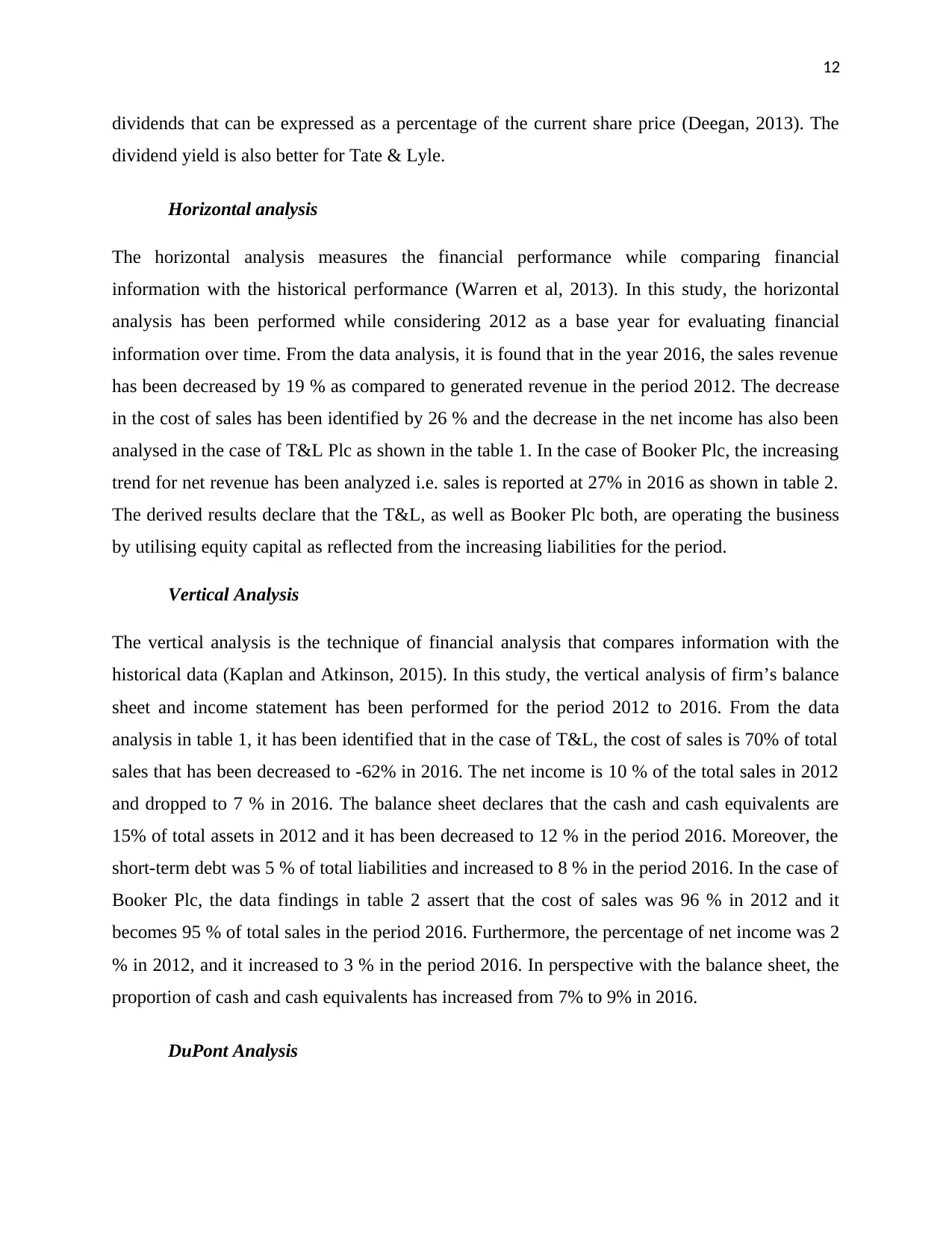
12
dividends that can be expressed as a percentage of the current share price (Deegan, 2013). The
dividend yield is also better for Tate & Lyle.
Horizontal analysis
The horizontal analysis measures the financial performance while comparing financial
information with the historical performance (Warren et al, 2013). In this study, the horizontal
analysis has been performed while considering 2012 as a base year for evaluating financial
information over time. From the data analysis, it is found that in the year 2016, the sales revenue
has been decreased by 19 % as compared to generated revenue in the period 2012. The decrease
in the cost of sales has been identified by 26 % and the decrease in the net income has also been
analysed in the case of T&L Plc as shown in the table 1. In the case of Booker Plc, the increasing
trend for net revenue has been analyzed i.e. sales is reported at 27% in 2016 as shown in table 2.
The derived results declare that the T&L, as well as Booker Plc both, are operating the business
by utilising equity capital as reflected from the increasing liabilities for the period.
Vertical Analysis
The vertical analysis is the technique of financial analysis that compares information with the
historical data (Kaplan and Atkinson, 2015). In this study, the vertical analysis of firm’s balance
sheet and income statement has been performed for the period 2012 to 2016. From the data
analysis in table 1, it has been identified that in the case of T&L, the cost of sales is 70% of total
sales that has been decreased to -62% in 2016. The net income is 10 % of the total sales in 2012
and dropped to 7 % in 2016. The balance sheet declares that the cash and cash equivalents are
15% of total assets in 2012 and it has been decreased to 12 % in the period 2016. Moreover, the
short-term debt was 5 % of total liabilities and increased to 8 % in the period 2016. In the case of
Booker Plc, the data findings in table 2 assert that the cost of sales was 96 % in 2012 and it
becomes 95 % of total sales in the period 2016. Furthermore, the percentage of net income was 2
% in 2012, and it increased to 3 % in the period 2016. In perspective with the balance sheet, the
proportion of cash and cash equivalents has increased from 7% to 9% in 2016.
DuPont Analysis
dividends that can be expressed as a percentage of the current share price (Deegan, 2013). The
dividend yield is also better for Tate & Lyle.
Horizontal analysis
The horizontal analysis measures the financial performance while comparing financial
information with the historical performance (Warren et al, 2013). In this study, the horizontal
analysis has been performed while considering 2012 as a base year for evaluating financial
information over time. From the data analysis, it is found that in the year 2016, the sales revenue
has been decreased by 19 % as compared to generated revenue in the period 2012. The decrease
in the cost of sales has been identified by 26 % and the decrease in the net income has also been
analysed in the case of T&L Plc as shown in the table 1. In the case of Booker Plc, the increasing
trend for net revenue has been analyzed i.e. sales is reported at 27% in 2016 as shown in table 2.
The derived results declare that the T&L, as well as Booker Plc both, are operating the business
by utilising equity capital as reflected from the increasing liabilities for the period.
Vertical Analysis
The vertical analysis is the technique of financial analysis that compares information with the
historical data (Kaplan and Atkinson, 2015). In this study, the vertical analysis of firm’s balance
sheet and income statement has been performed for the period 2012 to 2016. From the data
analysis in table 1, it has been identified that in the case of T&L, the cost of sales is 70% of total
sales that has been decreased to -62% in 2016. The net income is 10 % of the total sales in 2012
and dropped to 7 % in 2016. The balance sheet declares that the cash and cash equivalents are
15% of total assets in 2012 and it has been decreased to 12 % in the period 2016. Moreover, the
short-term debt was 5 % of total liabilities and increased to 8 % in the period 2016. In the case of
Booker Plc, the data findings in table 2 assert that the cost of sales was 96 % in 2012 and it
becomes 95 % of total sales in the period 2016. Furthermore, the percentage of net income was 2
% in 2012, and it increased to 3 % in the period 2016. In perspective with the balance sheet, the
proportion of cash and cash equivalents has increased from 7% to 9% in 2016.
DuPont Analysis
⊘ This is a preview!⊘
Do you want full access?
Subscribe today to unlock all pages.

Trusted by 1+ million students worldwide
1 out of 25
Related Documents
Your All-in-One AI-Powered Toolkit for Academic Success.
+13062052269
info@desklib.com
Available 24*7 on WhatsApp / Email
![[object Object]](/_next/static/media/star-bottom.7253800d.svg)
Unlock your academic potential
Copyright © 2020–2025 A2Z Services. All Rights Reserved. Developed and managed by ZUCOL.





